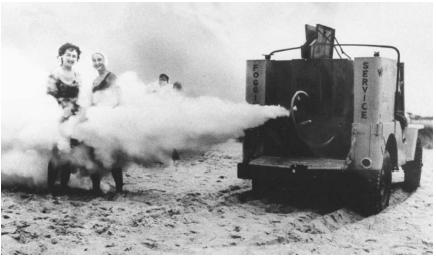 Imagine a group of gregarious nine and ten year old girls in the early 1960s, laughing and running through the streets of their neighborhood on a summer evening, following along behind a big truck -- a big truck spraying the pesticide DDT.
Imagine a group of gregarious nine and ten year old girls in the early 1960s, laughing and running through the streets of their neighborhood on a summer evening, following along behind a big truck -- a big truck spraying the pesticide DDT.
Now imagine those same girls as grown women, 30 years later, when many of them are fighting breast cancer, and some of them have already lost that fight. For them, the recent news of a link between DDT and breast cancer must be a little surreal.
Although scientists have long suspected a link between DDT exposure and breast cancer, most studies have turned up little or no evidence of a connection. But new research focusing on women's age of exposure found that those who were exposed to the pesticide in the years before puberty had their risk factor increase fivefold. It appears that, given the opportunity to enter the body before breast development, DDT goes to work on breast tissue.
DDT (dichloro-diphenyl-trichloroethane) was synthesized in 1875, but it's powers as a pesticide were discovered by a Swiss scientist (who patented his discovery and won a Nobel Prize for it as well) in the late 1930s. It was widely used during the second World War to combat insect-borne diseases, and in the 1950s and '60s it was sprayed widely through many American towns as pest control. To judge from comments and photos I've seen, running behind the fogger was a popular pastime for suburban children. Rachel Carson documented a link between DDT and declining bird populations (the chemical thins their eggshells) in her 1962 book Silent Spring. The pesticide was largely banned in the US ten years later, and subsequently banned for agricultural use worldwide.
Meanwhile, the World Health Organization has agreed to permit the use of DDT in interior home spraying in parts of Africa badly afflicted with malaria. Families are told to leave their house and stay away for a period of time (which many point out is not always possible), but even afterwards the pesticide's residue will remain on the walls and floors where babies and young children -- apparently the age group most likely to be affected -- will inevitably come into contact with it.
Those who clamor for the use of DDT (some of whom may stand to gain from the continued sale of the expensive chemical) to control malaria are setting up a false dichotomy: poison yourself with DDT or contract malaria. Malaria kills between one and three million people every year, so it's easy to see how spraying a dangerous pesticide might seem like an attractive option. But in fact DDT stopped working on many mosquito populations in Africa because those mosquitoes evolved ways to deal with the pesticide. Continued spraying is likely to lead to further genetic resistance.
Eventually, to combat resistant mosquitoes, nations using DDT to fight malaria will have to transition to another form of pest management. But many of those other alternatives exist already, and I'd guess that more are on the way. All that remains is for those funding the spraying of DDT to stop buying into the intentionally confusing messages of the chemical industry and start moving forward with a system that protects against both malaria and cancer. The issue is a lot more complex than the DDT-or-death rhetoric that surrounds it.